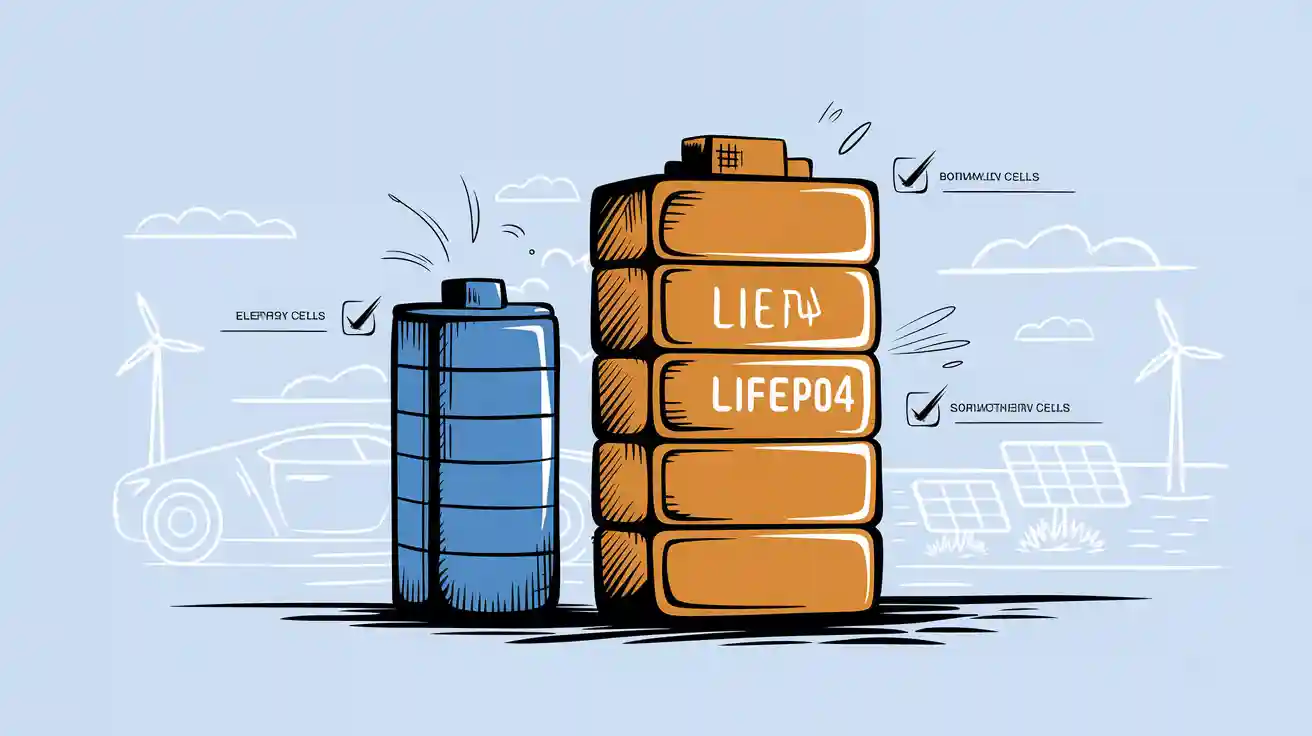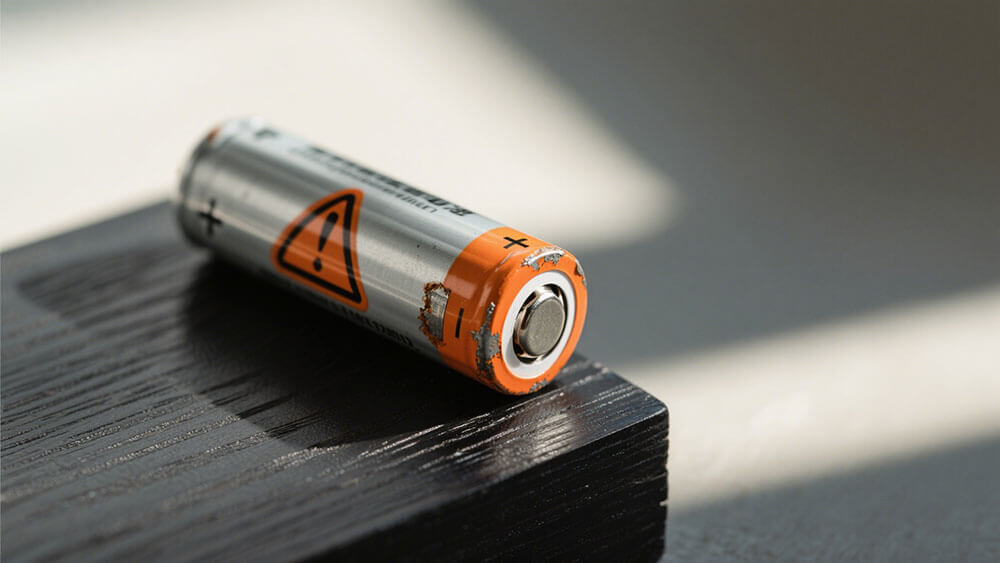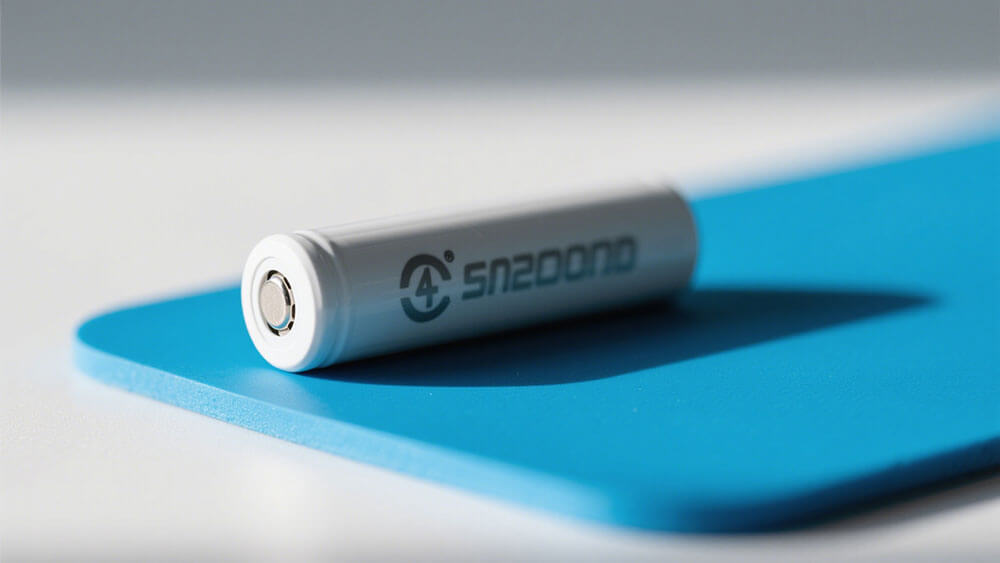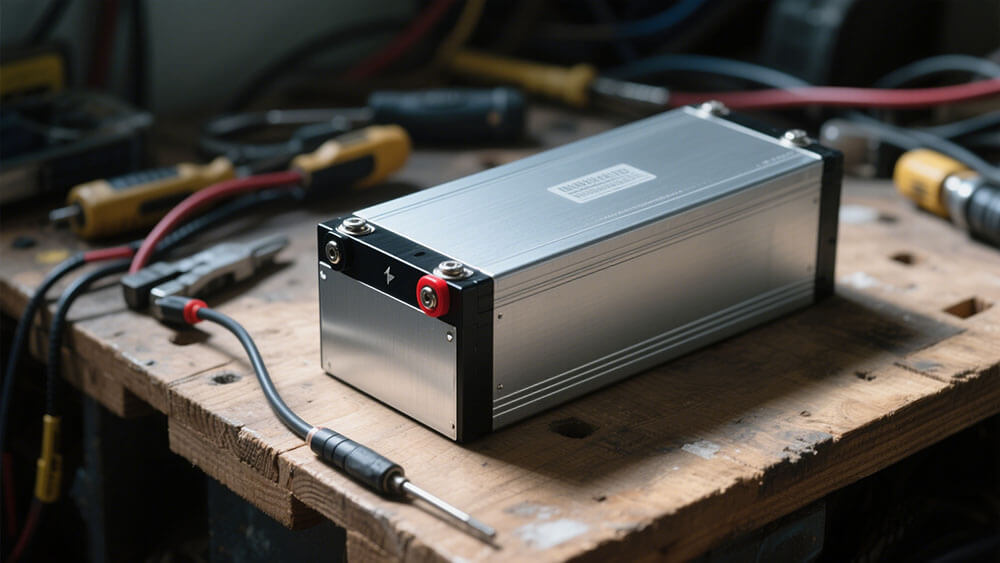
The debate surrounding LiFePO4 pouch cell vs LiFePO4 prismatic cell often hinges on their unique benefits. Pouch cells, known for their high energy density, cater to applications requiring compact designs. Prismatic cells, with their robust structure, excel in scenarios demanding longer cycle life and durability. Understanding these differences helps you determine which is better for your specific battery needs. So, which should you choose? Evaluate your application requirements carefully to make an informed decision.
For expert guidance on custom battery solutions, consult Large Power.
Key Takeaways
LiFePO4 pouch cells are light and bendable. They work well for portable things like drones and smartwatches.
LiFePO4 prismatic cells are strong and last long. They are great for tough uses like electric cars and big batteries.
Pick the right cell based on your needs. Pouch cells save space, while prismatic cells are tough and reliable.
Part 1: What Are LiFePO4 Pouch Cells?

1.1 Definition and Structure
LiFePO4 pouch cells are a type of lithium-ion battery designed with a flexible, lightweight casing. Unlike cylindrical or prismatic cells, pouch cells use a laminated aluminum polymer film as their enclosure. This design eliminates the need for heavy metal casings, reducing weight and increasing energy efficiency. The internal structure consists of stacked or folded layers of electrodes and separators, which are sealed within the pouch. This configuration allows for a compact and customizable form factor, making it ideal for applications where space and weight are critical.
1.2 Key Features of Pouch Cells
Pouch cells offer several unique features that set them apart from other battery types:
High Energy Density: These cells maximize energy storage within a compact design, making them suitable for portable and space-constrained applications.
Lightweight Construction: The absence of rigid casings reduces overall weight, enhancing mobility and efficiency.
Flexible Design: The pouch format allows for customization in size and shape, catering to diverse industrial and consumer needs.
Thermal Efficiency: The thin structure facilitates better heat dissipation, improving performance and safety.
Recent advancements in LiFePO4 pouch cell technology have further enhanced these features. For example, innovations in battery management systems (BMS) now improve safety and extend battery lifespan. Additionally, ongoing research focuses on faster charging and increased energy density, addressing the growing demand for efficient energy storage solutions.
1.3 Benefits of High Energy Density in Pouch Cells
The high energy density of LiFePO4 pouch cells provides significant advantages for various applications. These cells can store more energy per unit weight, making them ideal for industries like robotics, medical devices, and consumer electronics. For example, in robotics, the lightweight and compact design of pouch cells enhances mobility and operational efficiency. Similarly, in medical devices, the high energy density ensures reliable performance in critical situations.
A recent study highlights key trends in LiFePO4 pouch cell development:
Trend | Description |
|---|---|
Increased energy density | Ongoing research focuses on enhancing energy density to improve system performance. |
Faster charging | Innovations aim to reduce charging times to enhance user convenience. |
Improved safety features | Advanced designs prioritize safety and minimize the risk of thermal runaway. |
Smart battery management systems | Sophisticated BMS improve system efficiency and extend battery lifespan. |
These advancements make LiFePO4 pouch cells a preferred choice for applications requiring compact, efficient, and reliable energy solutions.
For custom battery solutions tailored to your specific needs, consult Large Power.
Part 2: What Are LiFePO4 Prismatic Cells?

2.1 Definition and Structure
LiFePO4 prismatic cells are lithium-ion batteries designed with a rectangular, rigid casing. These cells feature a robust external shell, typically made of aluminum or stainless steel, which provides structural integrity and protects internal components. Inside, the cell contains layers of electrodes, separators, and electrolytes arranged in a compact format. This design ensures efficient energy storage and reliable performance across various applications.
Component | Description |
|---|---|
Positive Electrode | Made of LiFePO4 with an olivine structure, responsible for lithium ion storage and release. |
Negative Electrode | Composed of carbon, facilitates the flow of electrons during discharge. |
Electrolyte | A medium that allows lithium ions to move between electrodes, essential for battery operation. |
Separator | A polymer layer that permits lithium ions to pass while preventing direct contact between electrodes. |
External Shell | Typically aluminum or stainless steel, provides structural integrity and safety. |
Battery Terminals | Positive and negative wiring ports for connection, marked for user convenience. |
Explosion-proof Valve | A safety feature to prevent accidents, ensuring the battery remains safe under pressure. |
Insulating Film | A protective layer that prevents electric shock and enhances safety. |
Busbars | Connects multiple cells in a battery pack, crucial for assembly. |
This structural composition makes LiFePO4 prismatic cells highly durable and suitable for demanding environments like industrial applications.
2.2 Key Features of Prismatic Cells
Prismatic cells offer several advantages that make them a preferred choice for energy storage solutions:
Durability: The rigid casing protects internal components, ensuring long-term reliability.
High Capacity: These cells deliver consistent energy output, making them ideal for large-scale applications.
Low Self-Discharge: Prismatic cells retain their charge over extended periods, reducing maintenance needs.
Safety Features: Explosion-proof valves and insulating films enhance operational safety.
A market analysis reveals that LiFePO4 prismatic cells are gaining traction due to technological innovations and rising demand. The competitive landscape highlights major players investing in advanced designs to improve performance and safety.
2.3 Benefits of Durability in Prismatic Cells
The durability of LiFePO4 prismatic cells offers significant advantages for applications in infrastructure, robotics, and security systems. Their rigid design withstands mechanical stress, making them ideal for environments with frequent vibrations or temperature fluctuations. For example, in infrastructure projects like transportation systems, prismatic cells ensure consistent energy delivery under challenging conditions.
Additionally, their long cycle life reduces replacement costs, enhancing sustainability. The explosion-proof valve and insulating film further improve safety, making these cells suitable for critical applications like security systems.
Explore how LiFePO4 prismatic cells can meet your energy storage needs with Large Power’s custom solutions.
Part 3: Key Differences Between Pouch and Prismatic Cells

3.1 Energy Density and Weight Comparison
Energy density and weight are critical factors when choosing between LiFePO4 pouch cells and prismatic cells. Pouch cells excel in energy density, offering 250-300 Wh/kg compared to prismatic cells’ 200-250 Wh/kg. This higher energy density allows pouch cells to store more energy per unit weight, making them ideal for applications requiring lightweight and compact designs, such as consumer electronics.
Parameter | Pouch Cells (LiFePO4) | Prismatic Cells (LiFePO4) |
|---|---|---|
Energy Density (Wh/kg) | 250-300 | 200-250 |
Weight | Lightweight | Heavier due to metal casing |
Cycle Life (@80% DoD) | 1,000 cycles | 1,500 cycles |
While pouch cells offer advantages in energy density, prismatic cells provide extended cycle life, making them more suitable for industrial applications where durability and longevity are essential.
For applications requiring lightweight energy solutions, explore Large Power’s custom battery solutions.
3.2 Durability and Mechanical Strength
Durability is a defining feature of prismatic cells. Their rigid metal casing enhances structural integrity, making them resistant to mechanical stress, vibrations, and shocks. This durability is particularly beneficial for infrastructure projects like transportation systems, where batteries must endure challenging conditions.
In contrast, pouch cells lack the mechanical strength of prismatic cells due to their flexible polymer casing. While this design reduces weight, it also makes pouch cells more susceptible to physical damage. For applications requiring robust performance, prismatic cells are the better choice.
Feature | Pouch Cells | Prismatic Cells |
|---|---|---|
Structural Strength | Less durable | Highly durable |
Resistance to Vibrations | Limited | Excellent |
Longevity | Shorter cycle life | Extended cycle life |
Prismatic cells also incorporate enhanced safety features, such as explosion-proof valves, which further improve reliability in demanding environments.
Learn more about durable energy solutions for infrastructure applications here.
3.3 Thermal Management and Safety
Thermal management plays a crucial role in battery performance and safety. Prismatic cells offer better heat management due to their metal casing, which facilitates efficient heat dissipation. This feature reduces the risk of overheating and improves overall safety.
Pouch cells, while compact, face challenges in thermal management. Their thin structure can lead to uneven heat distribution, increasing safety concerns in high-temperature environments. However, advancements in battery management systems (BMS) have mitigated these risks, enhancing the safety of pouch cells.
Feature | Pouch Cells | Prismatic Cells |
|---|---|---|
Cooling Efficiency | Less effective | Better heat management |
Safety Concerns | Higher risk of overheating | Lower risk due to improved dissipation |
For applications requiring increased safety and better heat management, prismatic cells are often the preferred choice.
Discover how advanced BMS can improve battery safety here.
3.4 Scalability and Design Flexibility
Scalability and design flexibility are key differences between pouch and prismatic cells. Pouch cells offer increased versatility due to their thin and lightweight design. Manufacturers can customize pouch cells to fit unique shapes and sizes, making them ideal for robotics and medical devices.
Prismatic cells, on the other hand, are easier to mass-produce due to their uniform shape. This production efficiency makes them cost-effective for large-scale applications, such as industrial energy storage systems.
Feature | Pouch Cells | Prismatic Cells |
|---|---|---|
Design Flexibility | Highly adaptable | Limited customization |
Production Efficiency | Complex to mass-produce | Easier to mass-produce |
Cost Considerations | Higher costs at scale | More cost-effective |
When choosing between pouch and prismatic cells, consider the trade-offs between versatility and production efficiency.
For custom battery solutions tailored to your needs, consult Large Power.
Part 4: Applications of LiFePO4 Pouch and Prismatic Cells

4.1 Best Use Cases for Pouch Cells
LiFePO4 pouch cells excel in applications where compactness, lightweight design, and high energy density are critical. Their flexible structure allows manufacturers to create custom shapes and sizes, making them ideal for industries that prioritize portability and space efficiency.
Common Pouch Cell Applications:
Wearable Devices: Smartwatches and fitness trackers benefit from the thin and lightweight design of pouch cells.
Drones: The high energy density ensures longer flight times without adding excessive weight.
Medical Devices: Portable medical equipment, such as infusion pumps and defibrillators, rely on pouch cells for reliable and compact energy storage.
IoT Devices: Smart home systems and industrial IoT sensors use pouch cells for their customizable form factor.
Mobile Robots: Robotics applications, such as warehouse automation, leverage the lightweight and efficient design of pouch cells. Explore robotics battery solutions here.
Pouch cells also find use in consumer electronics like laptops and smartphones, where their high energy density supports longer operational times. However, you should consider potential swelling issues in these applications, as highlighted by research from Sun et al. (2021). Swollen cells can exert pressure on surrounding components, leading to device deformation or failure.
Tip: For custom pouch cell solutions tailored to your specific needs, consult Large Power.
4.2 Best Use Cases for Prismatic Cells
Prismatic cells are the go-to choice for applications requiring durability, longevity, and efficient thermal management. Their rigid casing and robust design make them suitable for environments with physical stress or temperature fluctuations.
Common Prismatic Cell Applications:
Energy Storage Systems: Prismatic cells power large-scale solar and wind energy storage solutions due to their long cycle life and high capacity.
Electric Vehicles (EVs): Electric bicycles, motorcycles, and even automotive applications benefit from the durability and scalability of prismatic cells.
Power Tools: High-performance tools rely on prismatic cells for consistent energy output under demanding conditions.
Infrastructure Projects: Transportation systems and other infrastructure applications use prismatic cells for their reliability and ability to withstand vibrations.
Prismatic cells also offer better thermal management, reducing the risk of overheating in high-power applications. Their cost-effectiveness and ease of stacking make them a preferred choice for industrial energy storage systems. Explore industrial battery solutions here.
4.3 Choosing the Right Cell Type for Your Application
Selecting between LiFePO4 pouch and prismatic cells depends on your specific application requirements. Consider factors such as space constraints, durability, energy capacity, and budget.
Factor | Pouch Cells | Prismatic Cells |
|---|---|---|
Space Constraints | More flexible, better for limited space | Less flexible in size and shape |
Durability | Less durable than cylindrical cells | More durable, suitable for physical stress |
Energy Capacity | Lower specific energy | Slightly higher energy capacity |
Budget | Generally more expensive | More cost-effective |
Cycle Life | N/A | Longer lifespan |
Thermal Management | N/A | Better heat dissipation |
For applications like wearable devices or drones, pouch cells provide the flexibility and energy density you need. On the other hand, prismatic cells are better suited for electric vehicles and energy storage systems, where durability and thermal management are critical.
Note: Prismatic cells simplify battery pack assembly, making them ideal for applications like electric tricycles and rickshaws. Pouch cells, however, are perfect for achieving optimal power-to-weight ratios in electric motorcycles.
If you’re unsure which cell type aligns with your needs, consult experts at Large Power for tailored guidance.
Choosing between LiFePO4 pouch and prismatic cells depends on your application needs. Pouch cells offer lightweight, customizable designs, while prismatic cells provide durability and cost efficiency.
Feature | LiFePO4 Pouch Cells | LiFePO4 Prismatic Cells |
|---|---|---|
Slim Profile | Yes, as thin as 4mm | No, rigid rectangular shape |
Lightweight Construction | Yes, flexible pouches reduce weight | No, heavier due to metal casing |
Versatile Adaptability | Yes, can be customized for shapes | Limited adaptability due to rigid structure |
Evaluate your requirements carefully. Consulting experts ensures you select the optimal battery solution for your project.
FAQ
1. What are the main safety concerns with LiFePO4 pouch cells?
LiFePO4 pouch cells may swell under extreme conditions, potentially causing device deformation. Proper battery management systems (BMS) mitigate these risks and enhance safety.
2. How do prismatic cells handle high temperatures?
Prismatic cells excel in thermal management due to their metal casing, which dissipates heat efficiently. This reduces overheating risks in high-power applications.
3. Which cell type is more cost-effective for large-scale projects?
Prismatic cells are more cost-effective for large-scale applications. Their uniform shape simplifies production and assembly, reducing overall costs.
Tip: Consult experts to evaluate your project’s specific needs before choosing a cell type. If you’re unsure which cell type aligns with your needs, consult experts at Large Power for tailored guidance.




